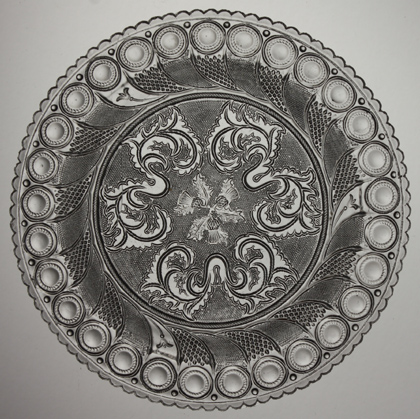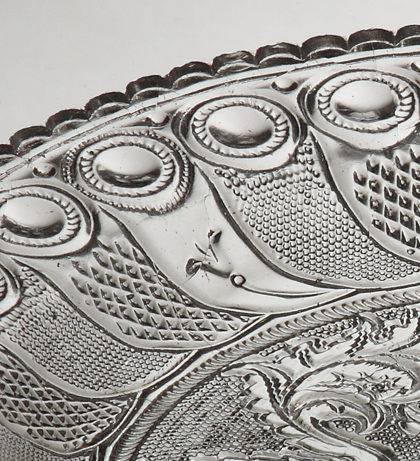A Floral Solution
The reason behind an unusual design choice can be as much to correct an earlier error as to achieve a desired effect.

Such is the case for this eight inch diameter pressed plate from the 1830s or early 40s and, in particular, the three commas in its border that contain stylized flowers rather than either tiny or small stippling.

These small flowers always seemed slightly out of place in this design, almost like a private joke, or a mold maker's signature. Indeed, among the twenty or more varieties of early pressed glass plate whose borders were inspired by an 1820s cut motif—the comet or peacock eye—only this eight inch diameter plate has those small flowers.
It has finally dawned on me that the flowers fix a problem, and what the mold maker had done wrong.
Can you figure it out?
Here's how I spotted the problem. I was counting the number of large circles around the edge of each of the different sizes of plate and, as a consequence, the number of commas. 24. 28. 30. 20. 24. 24. And so on.
This plate has 29. Literally, an odd number.
In order to have a nice border of alternating commas—shaded with small stipples then tiny stipples—you have to have an even number of commas.
Our poor mold maker found that he had 29 circles, and 29 commas to shade in. What to do?
One solution would have been to accept the error and include a repeat, either with two adjacent commas of tiny stipples, or two of small stipples side-by-side.
Another might have been to try a larger repeating pattern, perhaps a repeat of a triple—tiny then small then larger. If he had ended up with 27 circles and commas, then that would have worked. But unlike 27, 29 is not a multiple of 3. Worse, it is a prime number, and can only be filled with a repeat of 29 the same, or 29 different, which is no repeat at all!
The flowers resolve the problem. They break the border up, giving the illusion of three equal bands of commas, separated by flowers. But look closely, for it is only an illusion. While two alternating bands have 9 commas each, the other has only 8. One has small stipples at both ends, another tiny stipples at both ends, the third has small at one end and tiny at its other.
What sneaky little flowers. What a fine recovery by the mold maker.

